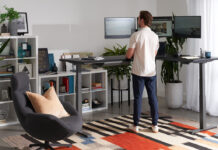As temperatures soar and heat waves become increasingly common, maintaining a comfortable working environment has never been more crucial. The discomfort of excessive heat doesn’t just affect our physical well-being; it substantially impacts productivity, focus, and overall workplace satisfaction. Creating a cool sanctuary within your office space during these scorching periods isn’t just about comfort—it’s about maintaining operational efficiency and protecting employee health. This comprehensive guide will walk you through practical, effective strategies to transform your sweltering office into a refreshing retreat where work can continue unhindered, even as temperatures outside climb to uncomfortable heights.
Understanding Heat’s Impact on Workplace Performance
Before diving into solutions, it’s important to recognize why heat management matters. Research consistently shows that cognitive function begins to decline when ambient temperatures rise above 77°F (25°C). Decision-making abilities, attention spans, and processing speed all diminish as our bodies work overtime to maintain internal temperature. A study published in the Harvard Business Review found that employees working in overheated environments made 44% more errors and were 46% less productive compared to those working in optimal temperature conditions.
Beyond productivity concerns, heat-related illnesses pose serious health risks. Heat exhaustion and heat stroke can develop rapidly, especially in poorly ventilated indoor environments where temperatures can actually exceed outdoor readings. Creating a cool office environment is therefore not merely a comfort consideration but a significant health and safety measure.
Strategic Cooling Solutions for the Modern Office
Optimizing Your HVAC System
Your first line of defense against oppressive heat should be ensuring your air conditioning system functions at peak efficiency:
- Schedule professional maintenance before summer begins to catch any potential issues
- Replace air filters monthly during heat waves, as dirty filters reduce efficiency by up to 15%
- Consider installing programmable thermostats that pre-cool spaces before employees arrive
- Set temperature zones if possible, focusing cooling power on areas with the most occupants or heat-generating equipment
For buildings with centralized cooling systems, speak with facility management about adjusting operating hours during extreme heat events. Many systems are programmed to power down after traditional business hours, but flexible work schedules may require extended cooling periods.
Harnessing the Power of Air Circulation
Even the best air conditioning systems benefit from enhanced air movement. Wall mounted fans create a wind-chill effect that can make a room feel several degrees cooler without changing the actual temperature. These space-efficient cooling solutions provide immediate relief while consuming significantly less energy than cranking up the air conditioning.
Strategic placement of wall mounted fans can transform air flow patterns throughout your office. Position them to create cross-ventilation, drawing cooler air from one area to another. Unlike portable floor fans that occupy valuable workspace and create tripping hazards, wall mounted fans operate safely above the fray, silently circulating air while preserving precious square footage.
Modern wall mounted fans come equipped with remote controls, oscillation features, and variable speed settings that allow precise customization of your cooling experience. By installing several throughout larger office spaces, you can create cooling zones without the expense of additional HVAC infrastructure.
Beating Solar Heat Gain
The sun’s radiant energy can rapidly heat interior spaces, even with functioning air conditioning. Managing this solar heat gain is essential:
- Install heat-reflective window films that block UV rays while maintaining natural light
- Utilize external blinds or shades that prevent heat from entering the building
- Consider light-colored window treatments that reflect rather than absorb heat
- Create shade with strategically placed indoor plants (which also improve air quality)
For offices undergoing renovation or those in planning stages, discuss heat-reflective glass options with your architect or contractor. These specialized windows can reduce heat transfer by up to 75% compared to standard glass.
Cooling the Human, Not Just the Space
Sometimes the most effective approach focuses on cooling individuals rather than entire rooms:
- Provide personal cooling options like small desk fans that supplement wall mounted fans
- Encourage hydration by making cold water readily available
- Consider relaxing dress codes during extreme heat waves
- Implement “cooling breaks” where employees can briefly visit air-conditioned break rooms
Some innovative offices have installed cooling stations—dedicated areas with enhanced cooling capabilities where employees can rotate through during the hottest parts of the day. These stations, equipped with powerful wall mounted fans and additional cooling elements, provide quick relief without the expense of cooling the entire facility to the same degree.
Tech and Equipment Management
Electronic equipment generates significant heat. Managing this thermal output helps keep temperatures down:
- Power down unnecessary equipment when not in use
- Ensure servers and networking equipment have adequate ventilation
- Consider switching to energy-efficient equipment that produces less heat
- Relocate heat-generating equipment away from employee workstations when possible
In server rooms or areas with concentrated equipment, dedicated wall mounted fans can help disperse hot air pockets that form around these heat sources. This targeted approach prevents thermal buildup while reducing the burden on your primary cooling system.
Creating Microclimate Zones
Rather than treating your office as a single thermal entity, consider creating microclimate zones:
- Designate certain areas as “cool zones” with enhanced cooling features
- Allow flexible seating arrangements during heat waves so employees can relocate to cooler areas
- Create buffer zones between heat-generating activities and primary work areas
- Use room dividers or plants to separate naturally warmer spaces from cooler ones
Wall mounted fans play a crucial role in maintaining these microclimates, helping to contain cooler air within designated zones while preventing stagnant hot air buildup in others. Their adjustable direction and intensity settings make them ideal for fine-tuning these environmental boundaries.
Sustainable Cooling Practices
As climate patterns evolve, sustainable cooling becomes increasingly important:
- Implement night purging—opening windows during cooler evening hours to pre-cool the building
- Consider installing smart blinds that automatically adjust based on sunlight intensity
- Explore green roof options that naturally insulate buildings against heat transfer
- Invest in energy audits to identify thermal weak points in your building envelope
Many offices are finding success with hybrid cooling approaches that combine mechanical cooling with passive strategies. For example, using wall mounted fans in conjunction with natural ventilation during moderate temperature periods can reduce mechanical cooling needs by up to 30% in some buildings.
Preparing for Future Heat Events
Climate projections suggest that extreme heat events will likely become more frequent and intense. Forward-thinking office managers are developing comprehensive heat management plans:
- Create clear protocols for different heat threshold levels
- Consider flexible work arrangements during extreme heat events
- Maintain emergency cooling options for HVAC system failures
- Train staff to recognize and respond to heat-related illness symptoms
Investing in durable, high-quality cooling infrastructure like professionally installed wall mounted fans represents a long-term approach to climate resilience. Unlike portable cooling solutions that often require replacement after a few seasons, properly installed wall units provide reliable performance year after year.
Conclusion
Transforming your office into a cool oasis during heat waves requires a multifaceted approach combining technological solutions, strategic planning, and human-centered design. By implementing the strategies outlined above, you can create a workplace that remains productive and comfortable even as temperatures climb. Remember that cooling investments not only enhance current workplace comfort but also prepare your organization for a future where managing heat effectively may become an increasingly important aspect of business continuity planning.
With thoughtful implementation of these cooling strategies—including the strategic placement of energy-efficient wall mounted fans throughout your space—your office can become that refreshing oasis where employees thrive regardless of the mercury’s climb outside.
Find a Home-Based Business to Start-Up >>> Hundreds of Business Listings.

















































